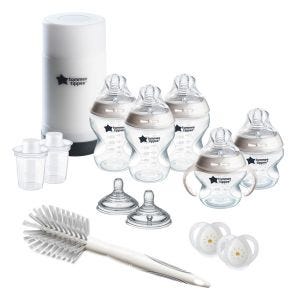
This is a demo store. No orders will be fulfilled.
Subscription orders can be cancelled at anytime. Free delivery on all subsequent subscription orders. Find out more about subscriptions.
They’re easy and fuss free
Your products are automatically sent to you
You save up to 10% when you sign up for a subscription
You can cancel at any time
No one's postpartum recovery timeline is the same, and it's so important to listen to your body before you try and get back to your pre-pregnancy workouts.
Don't compare yourself to others and certainly don't put pressure on yourself to 'snap back'. Try to enjoy the process and use your recovery time to celebrate everything that your amazing body has achieved!
If you're recovering from a vaginal birth, it's recommended that you wait until your six-week postpartum check to start any regular fitness regime. The Royal College of Obstetricians and Gynaecologists (RCOG) recommends that ���if pregnancy and delivery are uncomplicated, a mild exercise programme consisting of walking and pelvic floor exercises may begin immediately���.
The hormonal changes that happen during pregnancy can affect your joints and ligaments for up to five months after the birth, so it's best to take it easy at first, think little and often!
If you had a caesarean delivery, you'll need more time to recover than you would after a vaginal birth.
When you're a new mum gentle exercise can help by...
Find an activity that you enjoy and feel comfortable with, and then you can always build up the intensity over time. Remember to drink plenty of fluids before, during and after exercising, and wear a supportive bra and comfortable sneakers.
These important exercises strengthen the muscles around your bladder, vagina and bottom, and they can be done from the first few days after birth. You can practice them lying, sitting, or standing, and with a little practice, anywhere, at any time:
Aim to build up to 10 rounds of each exercise, at least 3 times a day. Remember, it's important to keep breathing normally and make sure you don't pull in your stomach when you squeeze. Try popping some notes around the house to help you remember!
The NHS says that ���it's common for the 2 muscles that run down the middle of your stomach to separate during pregnancy. This is called diastasis recti or divarication.���
These muscles should return to normal about 8 weeks after your baby is born. You can check the size of the separation using this simple technique:
Do this regularly to check that the gap is gradually getting smaller. If it's still obvious 8 weeks after birth, let your doctor know and they can refer you to a physiotherapist who'll give you some specific exercises.
Being pregnant, going through labour, and looking after a little one can put immense pressure on your back. Here are some tips to help you tackle back pain...
Swimming is a great, low-impact exercise that's also super relaxing. After birth, don't head the pool until you have had seven days without any bleeding or discharge, and if you've had a C-section, you should wait until your six-week check before taking a dip.
Joining a class - whether physical or virtual - is a great way to get back into your exercising groove and feel like a part of a community.
Oh Baby! Fitness' focus is to give new and expectant moms a place to find support, make friends, get fit and bond with their babies.
These are super convenient and can be done from the comfort of home. We've researched a few for you, but there are so many more out there!
You could also get in touch with your local yoga or pilates studio to find out what postpartum classes they offer. If you go to an exercise class that isn't designed specifically for new moms, make sure that your instructor knows that you've recently had a baby, that way they can tailor the exercises to you.
To sum up, be sure to take exercising after birth at your own pace, don't compare yourself to other moms, ask for advice from your doctor before starting something new, and enjoy those well-deserved endorphins!